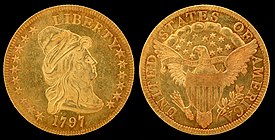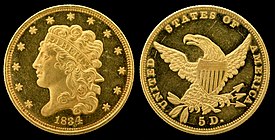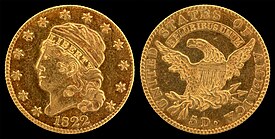Half eagle
Production of the half eagle was authorized by the Coinage Act of 1792, and it was the first gold coin minted by the United States.
The obverse design, or "Turban Head",[citation needed] depicted a capped portrait of Liberty facing to the right.
[1] Simultaneously, another type was minted that depicted a larger heraldic eagle on the reverse with the inscription "E PLURIBUS UNUM".
Another modification occurred in 1829 when the diameter of the coin was reduced slightly to 23.8 mm, although the overall design remained unchanged.By 1834, the gold in the half eagle had been worth more than its face value for several years.
Its weight was virtually the same, 8.359 grams, but the diameter was reduced one final time, to 21.6 mm, in 1840, for a gold content of 0.242 Troy Oz.
Scarcer dates and coins of higher grades can be worth much more, and all Charlotte, Carson City and Dahlonega pieces are scarce and valuable.
The composition, weight, and diameter of the coin remained unchanged, but both the obverse and reverse were drastically altered.
Production of the half eagle was suspended during World War I and not resumed until 1929, the final year of issue.
The San Francisco Mint first produced half eagles in 1854, its first year of operation, as did Carson City in 1870, and Denver in 1906.




